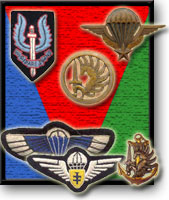509th Parachute Infantry Battalion
The 509th Parachute Infantry Battalion went through several numerical designations from it's initial activation on October 5, 1941 when it was first designated the 504th Parachute Battalion. It was redesignated the 2nd Battalion, 503rd Parachute Infantry on February 24, 1942. The final redesignation came on December 10, 1943 when it was designated the 509th Parachute Infantry Battalion. This was the designation that it held throughout World War II until its disbandment on March 1, 1945.
Operation Torch was the first joint military action undertaken by the Allies in World War II. This was the springboard for the Churchillian idea of attacking the soft underbelly of Europe before attempting a cross-channel attack from England. The main objective was to seize French Northwest Africa. For political reasons it would be an American led operation under the newly promoted Lieutenant General Dwight D. Eisenhower. The airborne segment of the operation entailed flying 1500 miles from England to seize two French airfields near Oran. Major William P Yarborough was selected to plan the logistics of the airborne phase and the 509th Parachute Infantry Battalion was chosen to execute it under the command of Lieutenant Colonel ( Lt Col) Edson Duncan Raff. Lt Col Raff later was assigned to command the 507th Parachute Infantry Regiment. The airborne phase of the operation was finally executed on November 8,1942 with disappointing results. As the planes approached the dropzone the French signaled their willingness to cooperate. However, not all of the French units were informed and there were last minute changes and decisions that led to confusion. Although Raff's group made the jump, controversy surrounded the operation. Irregardless, the 509th was undaunted and after a second jump a week later conducted combined operations with the French against the German Afrika Corps in Tunisia.
In addition to being the first airborne unit to participate in a combat jump, the 509th saw extensive action in Italy. The battalion was nearly destroyed when it was misdropped behind German lines at Salerno but survived to fight as mountain troops and stormed ashore with the Fifth Army at Anzio. After Anzio the battalion jumped into Southern France as part of the First Airborne Task Force where they again fought as mountain infantry.
When the order to deactivate the 509th Parachute Infantry Battalion was published by XVIII Airborne Corps Headquarters on March 1, 1945 there were only a handful of survivors who remained from it initial inception. These battle-hardened troopers were absorbed by the 82nd Airborne Division for the remainder of the war.


